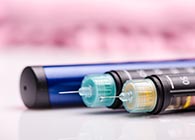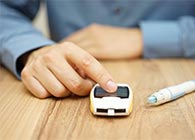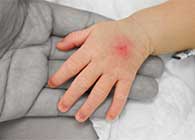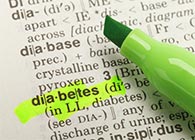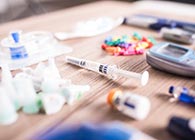January 2017
Diabetic neuropathy: a position statement by the American Diabetes Association
Rodica Pop-Busui et al. Diabetes Care. DOI: https://doi.org/10.2337/dc16-2042
This position statement from the American Diabetes Association is based on several recent technical reviews. It is a rich and detailed dissertation on diabetic neuropathy that covers:
Pathology, prevention, screening, treatment, and medication.
It deals with the multiple manifestations of neuropathy such as:
Peripheral, gastrointestinal, urinary, pain, psychosocial etc.
All chapters are accompanied by recommendations.
http://care.diabetesjournals.org/content/40/1/136
Efficacy of basal-bolus insulin regimens in the inpatient management of non-critically ill patients with type 2 diabetes
Merete B. Christensen et al. Diabetes/Metabolism Research and Reviews. DOI: 10.1002/dmrr.2885
Hyperglycemia during hospitalisation is associated with increased rates of complications and longer hospital stays. Various insulin regimens are used in the inpatient diabetes management of non-critically ill patients. This study assessed the efficacy and safety of basal-bolus insulin therapy (BBI) by summarising evidence from studies of BBI versus sliding scale insulin therapy (SSI) in the management of hospitalized non-critically ill type 2 diabetes patients. The authors of the review searched MEDLINE, EMBASE, and the Cochrane Library for studies. It found that there were significantly lower mean daily BG with BBI than SSI. BBI therapy was associated with increased risk of mild hypoglycemia compared with SSI therapy. There was no difference in risk of severe hypoglycemia and no difference in mean length of stay. Their conclusions were that basal-bolus insulin in the inpatient diabetes management results in significantly lower mean daily BG than sliding scale insulin but is associated with increased risk of mild hypoglycemia.
http://onlinelibrary.wiley.com/doi/10.1002/dmrr.2885/abstract
GAD vaccine reduces insulin loss in recently diagnosed type 1 diabetes
Craig A. Beam et al. Diabetologia. DOI: 10.1007/s00125-016-4122-1
GAD is a major target of the autoimmune response that occurs in type 1 diabetes mellitus. Randomised controlled clinical trials of a GAD + alum vaccine in human participants have so far given conflicting results. [Glutamic Acid Decarboxylase Autoantibodies (GAD) is used to help discover whether someone has either type 1 diabetes or Latent Autoimmune Diabetes of Adulthood]. This study sought a clearer answer to the question of whether GAD65 has an effect on C-peptide by estimating the probability of a positive biological effect (a reduction in C-peptide loss compared with placebo approximately 1 year after the GAD vaccine). [C-peptide is a protein that connects insulin’s A-chain to its B-chain in the proinsulin molecule. Measuring C-peptide can help to determine how much of a patient’s own natural insulin is being produced as C-peptide is secreted in equimolar amounts to insulin]. From their results the investigators estimated that there was a 98% probability that 20 μg GAD with alum administered twice yielded a positive biological effect. The effect was probably a 15–20% reduction in the loss of C-peptide at approximately 1 year after treatment. The authors suggest that the biological effect of this vaccination should be developed further in order to reach clinically desirable reductions in insulin loss in patients recently diagnosed with type 1 diabetes.
http://link.springer.com/article/10.1007%2Fs00125-016-4122-1
Paediatric parenting stress in fathers and mothers of young children with Type 1 diabetes
A. Nieuwesteeg et al. Diabetic Medicine. DOI: 10.1111/dme.13300
One hundred and twelve parents (56 mothers and 56 fathers) of young children (0–7 years) with Type 1 diabetes participated in this study. 44 mothers (79%) and 31 fathers (55%) completed the questionnaire again, 1 year later. It was found that mothers scored significantly higher than fathers on the stress subscales for: Communication, Emotional Distress, Medical Care frequency. Furthermore, fathers reported a decrease in Medical Care frequency and an increase in Emotional Distress, whereas mothers reported a decrease in Emotional Distress, Medical Care frequency over a 1-year period. The authors posit that their results show that within families with a young child with Type 1 diabetes, the burden of care increases in fathers and decreases in mothers, suggesting that fathers assume more responsibility for care of their child with Type 1 diabetes as the child grows.
http://onlinelibrary.wiley.com/doi/10.1111/dme.13300/abstract
Standards of medical care in diabetes – 2017: Summary of revisions
Diabetes Care. DOI: https://doi.org/10.2337/dc17-S003
Following the American Diabetes Association’s (ADA’s) new position statement on psychosocial care in the treatment of diabetes, the “Standards of Medical Care in Diabetes,” referred to as the “Standards of Care,” has been updated to address psychosocial issues in all aspects of care including self-management, mental health, communication, complications, comorbidities, and life-stage considerations. The brief summary is in 14 sections, each with new or updated recommendations added.
http://care.diabetesjournals.org/content/40/Supplement_1/S4
Glycemic targets
Diabetes Care. DOI: https://doi.org/10.2337/dc17-S009
Patient self-monitoring of blood glucose (SMBG) and HbA1C are available to health care providers and patients to assess the effectiveness and safety of the management plan on glycemic control. Continuous glucose monitoring (CGM) also has an important role in assessing the effectiveness and safety of treatment in subgroups of patients with type 1 diabetes and in selected patients with type 2 diabetes. This statement from the American Diabetes Association sets out 9 recommendations, and considers all the aspects in 5 sections with detailed sub-sections:
Assessment of glycemic control
Hba1c testing
Hba1c goals
Hypoglycemia
Intercurrent illness
http://care.diabetesjournals.org/content/40/Supplement_1/S48
Home use of a bihormonal bionic pancreas versus insulin pump therapy in adults with type 1 diabetes
Firas H El-Khatib et al. The Lancet. DOI: http://dx.doi.org/10.1016/S0140-6736(16)32567-3
The safety and effectiveness of a continuous, day-and-night automated glycaemic control system using insulin and glucagon has not been shown in a free-living, home-use setting. This study to assessed whether bihormonal bionic pancreas initialised only with body mass could safely reduce mean glycaemia and hypoglycaemia in adults with type 1 diabetes who were living at home and participating in their normal daily routines without restrictions on diet or physical activity. It looked at 43 volunteers (at least 18 years old) who had type 1 diabetes at four sites in the USA. The findings were that relative to conventional and sensor-augmented insulin pump therapy, the bihormonal bionic pancreas, initialised only with participant weight, was able to achieve superior glycaemic regulation without the need for carbohydrate counting.
http://www.thelancet.com/journals/lancet/article/PIIS0140-6736(16)32567-3/fulltext
Fear of self-injecting and self-testing and the related risk factors in adolescents with type 1 diabetes
Ayman A. Al Hayek et al. Diabetes Therapy. DOI: 10.1007/s13300-016-0221-8
This study looked at the fear of self-injecting and self-testing and its related risk factors among adolescents with type 1 diabetes mellitus (T1DM). It was performed at the Diabetes Treatment Center, Riyadh, Saudi Arabia on 142 registered T1DM patients between 13 and 19 years of age. It found that adolescents above 16 years of age, treated with multiple daily insulin (MDI), on higher insulin doses, having poor glycemic control, and fewer finger pricks were observed to show significant risk factors for fear of self-injection of insulin. The authors assert that because fear of self-injecting and fear of self-testing are common among adolescents with T1DM, it is essential to ensure comprehensive multidisciplinary diabetes education to lower the risk factor of fear of injections.
http://link.springer.com/article/10.1007%2Fs13300-016-0221-8
Lower basal insulin dose is associated with better control in type 1 diabetes
David Strich et al. The Journal of Pediatrics. DOI: http://dx.doi.org/10.1016/j.jpeds.2016.11.029
This study tested the hypothesis that lower basal insulin doses may be paradoxically associated with better diabetic control. It assessed the association between the basal insulin dose and HbA1c in a group of children and young adults with type 1 diabetes. The retrospective study looked at 89 patients with type 1 diabetes treated in a single outpatient clinic. It found that there was a significant correlation between injection of less total daily basal insulin and lower HbA1c level. The authors concluded that with lower basal insulin levels, lower HbA1C was achieved despite the same total bolus dose. http://www.jpeds.com/article/S0022-3476(16)31258-6/fulltext
Diabetes device use in adults with type 1 diabetes: barriers to uptake and potential intervention targets
Molly L. Tanenbaum et al. Diabetes Care. DOI: https://doi.org/10.2337/dc16-1536
Diabetes devices (insulin pumps, continuous glucose monitors [CGMs]) are associated with benefits for glycemic control, yet uptake of these devices continues to be low. Some barriers to device uptake may be modifiable through psychosocial intervention, but little is known about which barriers and which patients to target. This investigation surveyed 1,503 adults with T1D to investigate barriers to device uptake, understand profiles of device users versus nonusers, and explore differences by age and sex. The most commonly modifiable barriers were related to the hassle of wearing devices (47%) and disliking devices on one’s body (35%). CGM users (37%) were older than nonusers, had diabetes for longer had more positive technology attitudes, and reported fewer barriers to using diabetes technology than nonusers. The youngest age-group (18–25 years) had the lowest CGM and insulin pump uptake, highest diabetes distress, and highest A1C levels. The authors advise that efforts to increase device use need to target physical barriers to wearing devices. Because young adults had the lowest device uptake rates, highest distress, and highest HbA1C when compared with older age-groups, they should be the focus of future interventions to increase device use.
http://care.diabetesjournals.org/content/early/2016/11/21/dc16-1536


